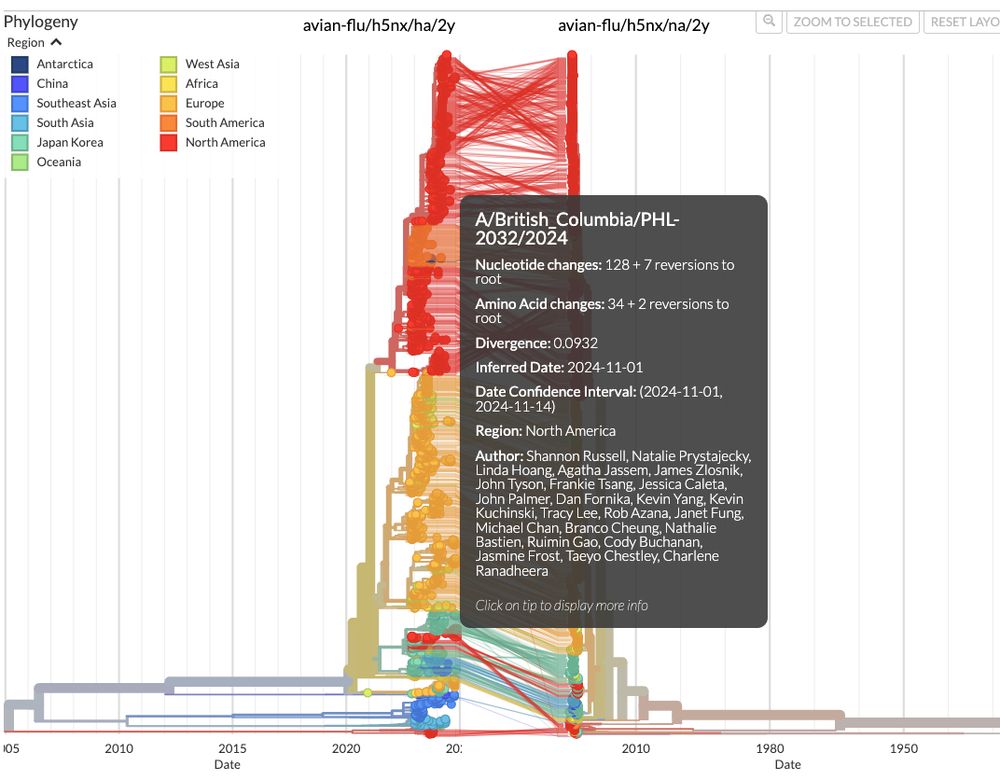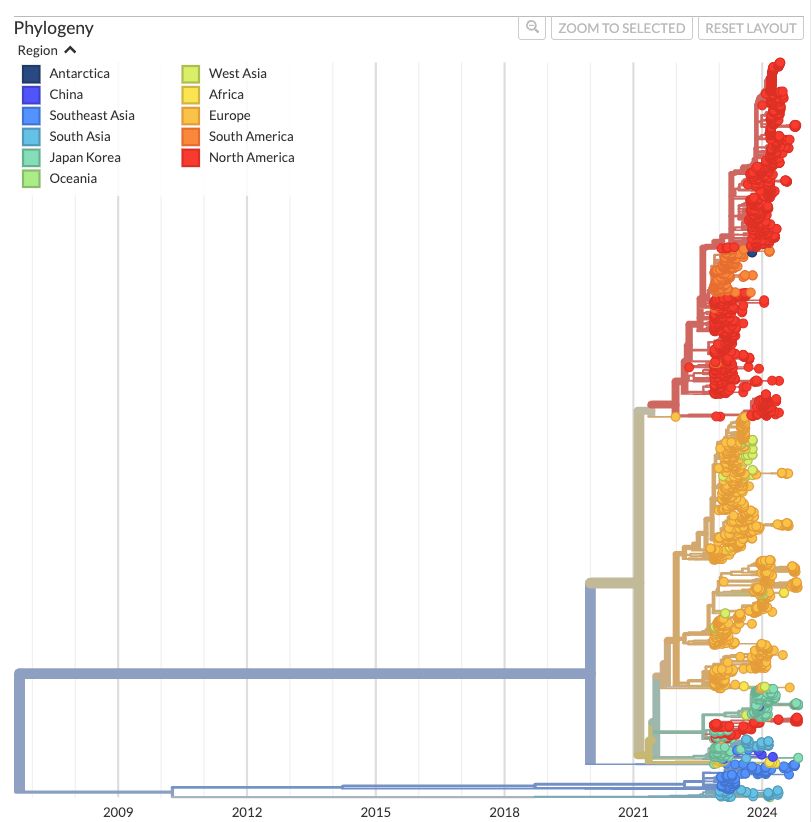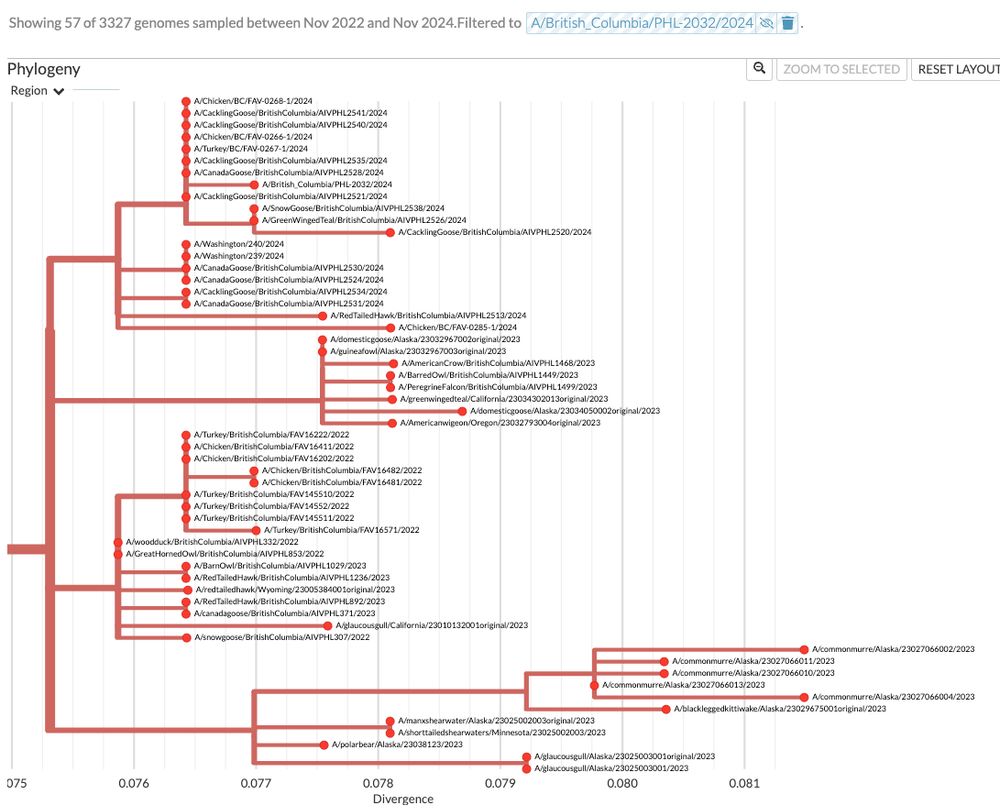
Louise H. Moncla
@lhmoncla.bsky.social
Assistant Professor of Pathobiology at the University of Pennsylvania. We use trees to study RNA virus evolution and transmission, with a focus on avian influenza. viruses, sequencing, phylogenetics, pop gen. She/her
https://lmoncla.github.io/monclalab/
https://lmoncla.github.io/monclalab/
We have the best resolution with clades with large reference sets (the 2.3.4.4s and 2.3.2.1s), and poorer matching for clades that are historic and small (2.4, 3) or the "like" clades, which are catch-alls for sequences that don't neatly fall into monophyletic clades.

January 10, 2025 at 10:21 PM
We have the best resolution with clades with large reference sets (the 2.3.4.4s and 2.3.2.1s), and poorer matching for clades that are historic and small (2.4, 3) or the "like" clades, which are catch-alls for sequences that don't neatly fall into monophyletic clades.
clade-defining mutations to generate a reference tree with clades defined at internal nodes. We then benchmarked the performance against LABEL, and found that Nextclade assignments were quite a bit faster, and generally well-matched with LABEL assignments.

January 10, 2025 at 10:21 PM
clade-defining mutations to generate a reference tree with clades defined at internal nodes. We then benchmarked the performance against LABEL, and found that Nextclade assignments were quite a bit faster, and generally well-matched with LABEL assignments.
represent a new, recent introduction from Asia is unclear. One thing that is clear is that these viruses represent a new reassortant event. They harbor a clade 2.3.4.4b HA with a highly divergent N1 NA gene from low path viruses that are endemic in North America. There has been a lot of reassortment

November 17, 2024 at 7:59 PM
represent a new, recent introduction from Asia is unclear. One thing that is clear is that these viruses represent a new reassortant event. They harbor a clade 2.3.4.4b HA with a highly divergent N1 NA gene from low path viruses that are endemic in North America. There has been a lot of reassortment
descends from an introduction from Europe in 2021. The HA sequences from British Columbia are not part of that lineage. Instead, they descend from a separate set of introductions that occurred into the Pacific coast in 2022 from Asia (red cluster nested within green in the tree above, closeup here)

November 17, 2024 at 7:59 PM
descends from an introduction from Europe in 2021. The HA sequences from British Columbia are not part of that lineage. Instead, they descend from a separate set of introductions that occurred into the Pacific coast in 2022 from Asia (red cluster nested within green in the tree above, closeup here)
The vast majority of the epizootic in North America descends from a single introduction of H5N1 from Europe in late 2021, which spread across North America into South America, and recently spilled into dairy cattle in the US. Said another way, the HA lineage infecting cattle ...

November 17, 2024 at 7:59 PM
The vast majority of the epizootic in North America descends from a single introduction of H5N1 from Europe in late 2021, which spread across North America into South America, and recently spilled into dairy cattle in the US. Said another way, the HA lineage infecting cattle ...
All gene segments from the British Columbia virus cluster together with a group of viruses sampled from wild and domestic birds in British Columbia, along with viruses sampled from two humans in Washington State who were infected while depopulating infected poultry. A closeup of HA

November 17, 2024 at 7:59 PM
All gene segments from the British Columbia virus cluster together with a group of viruses sampled from wild and domestic birds in British Columbia, along with viruses sampled from two humans in Washington State who were infected while depopulating infected poultry. A closeup of HA
onto the clade 2.3.4.4 dataset will give a clade assignment and place the sequences on the clade 2.3.4.4 reference tree. We've added a few extra annotations onto these datasets, like a polybasic cleavage site annotation, cleavage site sequence, and glycosylation sites.


May 14, 2024 at 3:44 PM
onto the clade 2.3.4.4 dataset will give a clade assignment and place the sequences on the clade 2.3.4.4 reference tree. We've added a few extra annotations onto these datasets, like a polybasic cleavage site annotation, cleavage site sequence, and glycosylation sites.
You should now be able to select one of these datasets, drag and drop a fasta file, and get an output with a clade assignment, quality control metrics, and a visualization of where these sequences fall on the reference tree. For example, dragging on a few recent cattle sequences

May 14, 2024 at 3:43 PM
You should now be able to select one of these datasets, drag and drop a fasta file, and get an output with a clade assignment, quality control metrics, and a visualization of where these sequences fall on the reference tree. For example, dragging on a few recent cattle sequences
New tool announcement! Thanks to a lot of work from Jordan Ort (an awesome student in the lab), with help from
@richardneher
, Todd Davis, Tommy Lam, and Sam Shepard, the H5s are now on Nextclade! clades.nextstrain.org A thread below:
@richardneher
, Todd Davis, Tommy Lam, and Sam Shepard, the H5s are now on Nextclade! clades.nextstrain.org A thread below:

May 14, 2024 at 3:41 PM
New tool announcement! Thanks to a lot of work from Jordan Ort (an awesome student in the lab), with help from
@richardneher
, Todd Davis, Tommy Lam, and Sam Shepard, the H5s are now on Nextclade! clades.nextstrain.org A thread below:
@richardneher
, Todd Davis, Tommy Lam, and Sam Shepard, the H5s are now on Nextclade! clades.nextstrain.org A thread below:
None of the PB2 sequences harbor known adaptive markers 627K or 701N, and instead harbor the avian-type 627E and 701D sequences. All dairy cattle internal genes cluster most closely with the exact same set of bird sequences, consistent with a direct transmission from wild birds.


April 1, 2024 at 8:47 PM
None of the PB2 sequences harbor known adaptive markers 627K or 701N, and instead harbor the avian-type 627E and 701D sequences. All dairy cattle internal genes cluster most closely with the exact same set of bird sequences, consistent with a direct transmission from wild birds.
None have amino acid changes in HA. The goat sequences from Minnesota cluster separately from the cows, and are most similar to a pheasant sequence from Colorado, though no bird sequences that were identical have been sampled. All ruminant sequences are 2.3.4.4b viruses.

April 1, 2024 at 8:46 PM
None have amino acid changes in HA. The goat sequences from Minnesota cluster separately from the cows, and are most similar to a pheasant sequence from Colorado, though no bird sequences that were identical have been sampled. All ruminant sequences are 2.3.4.4b viruses.
which we have now added to the H5Nx North America build. Taking a look a the HA tree, we can see that all dairy cow sequences clearly nest with wild bird sequences sampled from Texas around the same time. 5/6 dairy cow sequences are identical, 1 differs by 1 nt. ...

April 1, 2024 at 8:46 PM
which we have now added to the H5Nx North America build. Taking a look a the HA tree, we can see that all dairy cow sequences clearly nest with wild bird sequences sampled from Texas around the same time. 5/6 dairy cow sequences are identical, 1 differs by 1 nt. ...
Have you been wondering what's going on with avian influenza in North America? Check out our lab's @nextstrain narrative on phylodynamic analysis of H5Nx evolution and transmission here! nextstrain.org/groups/moncl...

February 20, 2024 at 4:17 PM
Have you been wondering what's going on with avian influenza in North America? Check out our lab's @nextstrain narrative on phylodynamic analysis of H5Nx evolution and transmission here! nextstrain.org/groups/moncl...

